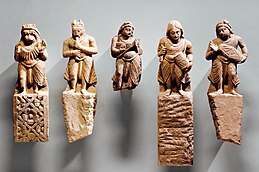Tabla
The tabla[nb 1] is a pair of twin hand drums from the Indian subcontinent. Since 18th century, tabla has been the principal percussion instrument in Hindustani classical music,[3] where it may be played solo, as accompaniment with other instrument and vocals, and as a part of larger ensembles. Tabla is also frequently played in popular and folk music performances in India, Bangladesh, Pakistan, Afghanistan, Nepal, and Sri Lanka.[4] The tabla is also an important instrument in the bhakti devotional traditions of Hinduism and Sikhism, such as during bhajan and kirtan singing.[5][6] It is one of the main qawali instrument used by Sufi musicians.[7] Tabla also features in dance performances such as Kathak.[8]
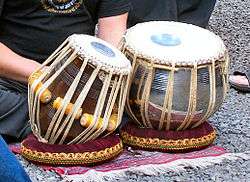 | |
| Percussion instrument | |
|---|---|
| Classification | Membranophone percussion instrument |
| Hornbostel–Sachs classification | 211.12 (Sets of instruments in which the body of the drum is dish- or bowl-shaped) |
| Developed | 18th century, North India (modern tabla) |
| Playing range | |
| One octave (variable)[1][2] | |
| Related instruments | |
| Pakhavaj, mridangam, khol, dholak, nagara, madal, tbilat | |
The name tabla likely comes from tabl, the Persian and Arabic word for drum.[9] The ultimate origin of the musical instrument is contested by scholars, though some trace its evolution from indigenous musical instruments of the Indian subcontinent.[10]
The tabla consists of two small drums of slightly different sizes and shapes.[4][11] Each drum is made of hollowed out wood, clay or metal. The smaller drum (daya) is used for creating treble and tonal sounds, while the primary function of the larger drum (bayan) is for producing bass. They are laced with hoops, thongs and wooden dowels on its sides. The dowels and hoops are used to tighten the tension of the membranes for tuning the drums.[12]
The playing technique is complex and involves extensive use of the fingers and palms in various configurations to create a wide variety of different sounds and rhythms, reflected in mnemonic syllables (bol).
Origins
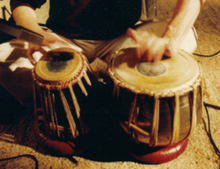
The history of tabla is unclear, and there are multiple theories regarding its origins.[10][13] There are two groups of theories, one that traces its origins to Muslim and Mughal invaders of the Indian subcontinent, the other traces it to indigenous origins.[10] One example of the latter theory is carvings in Bhaja Caves. However, clear pictorial evidence of the drum emerges only from about 1745, and the drum continued to develop in shape until the early 1800s.[14]
Indian origins
The Indian theory traces the origin of tabla to indigenous ancient civilization. The stone sculpture carvings in Bhaja Caves depict a woman playing a pair of drums, which some have claimed as evidence for the ancient origin of the tabla in India.[17][18] A different version of this theory states that the tabla acquired a new Arabic name during the Islamic rule, having evolved from ancient Indian puskara drums. The evidence of the hand-held puskara is founded in many temple carvings, such as at the 6th and 7th century Muktesvara and Bhuvaneswara temples in India.[13][15][19] These arts show drummers who are sitting, with two or three separate small drums, with their palm and fingers in a position as if they are playing those drums.[15] However, it is not apparent in any of these ancient carvings that those drums were made of the same material and skin, or played the same music, as the modern tabla.[15]
The textual evidence for similar material and methods of construction as tabla comes from Sanskrit texts. The earliest discussion of tabla-like musical instrument building methods are found in the Hindu text Natyashastra. This text also includes descriptions of paste-patches (syahi) such as those found on a tabla.[15] The Natyashastra also discusses how to play these drums. The South Indian text Silappatikaram, likely composed in the early centuries of 1st millennium CE, describes thirty types of drums along with many stringed and other instruments. These are, however, called pushkara; the name tabla appears in later periods.[20]
Muslim and Mughal origins
This theory is based on the etymological links of the word tabla to Arabic word tabl which means "drum". Beyond the root of the word, this proposal points to the documentary evidence that the Muslim armies had hundreds of soldiers on camels and horses carrying paired drums as they invaded the Indian subcontinent. They would beat these drums to scare the residents, the non-Muslim armies, their elephants and chariots, that they intended to attack. However, the war drums did not look or sound anything like tabla, they were large paired drums and were called naqqara (noise, chaos makers).[10]
Another version states that Amir Khusraw, a musician patronized by Sultan Alauddin Khalji invented the tabla when he cut an Awaj drum, which used to be hourglass shaped, into two parts. However, no painting or sculpture or document dated to his period supports it with this evidence nor it was found in the list of musical instruments that were written down by Muslim historians. For example, Abul Fazi included a long list of musical instruments in his Ain-i-akbari written in the time of the 16th century Mughal Emperor Akbar, the generous patron of music. Abul Fazi's list makes no mention of tabla.[10]
The third version credits the invention of tabla to the 18th century musician, with a similar sounding name Amir Khusru, where he is suggested to have cut a Pakhawaj into two to create tabla. Miniature paintings of this era show instruments that sort of look like tabla. This theory implies that tabla emerged from within the Muslim community of Indian subcontinent and were not an Arabian import.[10][21] However, scholars such as Neil Sorrell and Ram Narayan state that this legend of cutting a pakhawaj drum into two to make tabla drums "cannot be given any credence".[12]
History
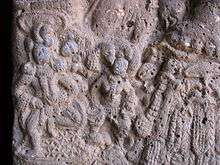
Drums and Talas are mentioned in the Vedic era texts.[23][24] A percussion musical instrument with two or three small drums, held with strings, called Pushkara (also spelled Pushkala) were in existence in pre-5th century Indian subcontinent along with other drums such as the Mridang, but these are not called tabla then.[25] The pre-5th century paintings in the Ajanta Caves, for example, show a group of musicians playing small tabla-like upright seated drums, a kettle-shaped mridang drum and cymbals.[26] Similar artwork with seated musicians playing drums, but carved in stone, are found in the Ellora Caves,[27] and others.[28]
A type of small Indian drums, along with many other musical instruments, are also mentioned in Tibetan and Chinese memoirs written by Buddhist monks who visited the Indian subcontinent in the 1st millennium CE. The pushkala are called rdzogs pa (pronounced dzokpa) in Tibetan literature.[29] The pushkara drums are also mentioned in many ancient Jainism and Buddhism texts, such as Samavayasutra, Lalitavistara and Sutralamkara.[30]
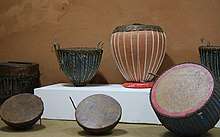
Various Hindu and Jain temples, such as the Eklingji in Udaipur, Rajasthan show stone carvings of a person playing tabla-like small pair of drums. Small drums were popular during the Yadava rule (1210 to 1247) in the south, at the time when Sangita Ratnakara was written by Sarangadeva. Madhava Kandali, 14th century Assamese poet and writer of Saptakanda Ramayana, lists several instruments in his version of "Ramayana", such as tabal, jhajhar, dotara, vina, rudra-vipanchi, etc. (meaning that these instruments existed since his time in 14th century or earlier).There is recent iconography of the tabla dating back to 1799.[31] This theory is now obsolete with iconography carvings found in Bhaje caves providing solid proof that the tabla was used in ancient India. There are Hindu temple carvings of double hand drums resembling the tabla that date back to 500 BCE.[32] The tabla was spread widely across ancient India. A Hoysaleshwara temple in Karnataka shows a carving of a woman playing a tabla in a dance performance.[33]
Construction and features
The tabla consists of two single-headed, barrel-shaped small drums of slightly different sizes and shapes: daya and baya for left and right drums respectively.[4][11]
The smaller drum, played with the dominant hand, is called dayan (literally "right" side ), dāhina, siddha or chattū, but is correctly called the "tabla." It is made from a conical piece of mostly teak and rosewood hollowed out to approximately half of its total depth. The daya tabla is played by the musician's right hand (dominant hand), and is about 15 centimetres (~6 in) in diameter and 25 centimetres (~10 in) high. The drum is tuned to a specific note, usually either the tonic, dominant or subdominant of the soloist's key and thus complements the melody. This is the ground note of the raga called Sa (tonic in India music).[4] The tuning range is limited although different dāyāñs are produced in different sizes, each with a different range. Cylindrical wood blocks, known as gatta, are inserted between the strap and the shell allowing tension to be adjusted by their vertical positioning. Fine tuning is achieved while striking vertically on the braided portion of the head using a small, heavy hammer. While tabla usually features two drums, a tabla tarang may consist of 10-16 dayas to perform melodies based on several ragas.
The baya tabla is a bit bigger and deep kettledrum shaped, about 20 centimetres (~8 in) in diameter and 25 centimetres (~10 in) in height. It played with the non-dominant hand, is called bāyāñ (literally "left") duggī or dhāmā (correctly called "dagga"), has a much deeper bass tone, much like its distant cousin, the kettle drum. The bāyāñs can be found to be made up of many different types of materials. Brass is the most common, copper is more expensive, but generally held to be the best, while aluminum and steel are often found in inexpensive models. Sometimes wood is used, especially in old bāyāñs from the Punjab. Clay is also used, although not favored for durability; these are generally found in the North-East region of Bengal. The baya construction and tuning is about a fifth to an octave below that of the daya drum. The musician uses his hand's heel pressure to change the pitch and tone colour of each drum during a performance.[4][12]
The head of each drum has a central area of "tuning paste" called the syahi (lit. "ink"; a.k.a. shāī or gāb). Syahi is common in many drums of Indian origin. This method allows these drums to produce harmonic overtones and is responsible for their unique sound.[34] Syahi is constructed using multiple layers of a paste made from starch (rice or wheat) mixed with a black powder of various origins. The precise construction and shaping of this area is responsible for modification of the drum's natural overtones, resulting in the clarity of pitch (see inharmonicity) and variety of tonal possibilities unique to this instrument which has a bell-like sound. The skill required for the proper construction of this area is highly refined and is the main differentiating factor in the quality of a particular instrument. The earliest discussion of these paste-patches are found in the Hindu text Natyashastra.[35]
For stability while playing, each drum is positioned on a toroidal bundle called chutta or guddi, consisting of plant fiber or another malleable material wrapped in cloth.
Musical notation
Indian music is traditionally practice-oriented and until the 20th century did not employ written notations as the primary media of instruction, understanding, or transmission. The rules of Indian music and compositions themselves are taught from a guru to a shishya, in person. Thus oral notation, such as the tabla stroke names, is very developed and exact. However, written notation is regarded as a matter of taste and is not standardized. Thus there is no universal system of written notation for the rest of the world to study Indian music.
Maula Bakhsh (born as Chole Khan in 1833) was an Indian musician, singer and poet. His grandson was Inayat Khan, founder of Universal Sufism. He developed the "first system of notation for Indian music". He also founded the "first Academy of Music in India" in 1886, based in Baroda that encompassed both Eastern and Western musical cultural traditions.[36]
Basic strokes
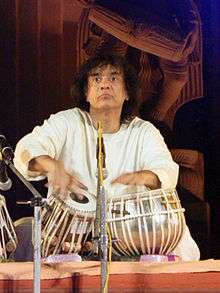
Tabla's repertoire and techniques borrow many elements from Pakhavaj and Mridangam, which are played sideways using one's palms. The physical structure of these drums also share similar components: the smaller pakhavaj head for the dayan, the naqqara kettledrum for the bayan, and the flexible use of the bass of the dholak.[37] Tabla is played from the top and uses "finger tip and hand percussive" techniques allowing more complex movements.[38]
Some basic strokes with the dayan on the right side and the bayan on the left side are:
- Ta: (on dayan) striking sharply with the index finger against the rim while simultaneously applying gentle pressure to the edge of the syahi with the ring finger to suppress the fundamental vibration mode
- Ghe or ga: (on bayan) holding wrist down and arching the fingers over the syahi; the middle and ring-fingers then strike the maidan (resonant)
- gha (on bayan) striking the index finger
- Tin: (on dayan) placing the last two fingers of the right hand lightly against the syahi and striking on the border between the syahi and the maidan (resonant)
- Dha: combination of Na and (Ga or Gha)
- Dhin: combination of Tin and (Ga or Gha)
- Ka or kath: (on bayan) striking with the flat palm and fingers (non resonant)
- Na: (on dayan) striking the edge of the syahi with the last two fingers of the right hand
- Te: (on dayan) striking the center of the syahi with the middle finger (non resonant)
- Tu | Tun:[39] (on dayan) striking the center of the syahi with the index finger to excite the fundamental vibration mode (resonant)
- Dhere dhere (on dayan) striking of syahi with palm
Tabla Taals

Some taals, for example Dhamaar, Ek, Jhoomra and Chau tals, lend themselves better to slow and medium tempos. Others flourish at faster speeds, pratham bhagati like Jhap or Rupak talas. Trital or Teental is one of the most popular, since it is as aesthetic at slower tempos as it is at faster speeds.
There are many taals in Hindustani music. Some of the more popular ones are:
| Name | Beats | Division | Vibhag |
|---|---|---|---|
| Tintal (or Trital or Teental) | 16 | 4+4+4+4 | X 2 0 3 |
| Jhoomra | 14 | 3+4+3+4 | X 2 0 3 |
| Tilwada | 16 | 4+4+4+4 | x 2 0 3 |
| Dhamar | 14 | 5+2+3+4 | X 2 0 3 |
| Ektal and Chautal | 12 | 2+2+2+2+2+2 | X 0 2 0 3 4 |
| Jhaptal (or Japtal) | 10 | 2+3+2+3 | X 2 0 3 |
| Keherwa | 8 | 4+4 | X 0 |
| Rupak (Mughlai/Roopak) | 7 | 3+2+2 | 0 X 2 |
| Dadra | 6 | 3+3 | X 0 |
Rare Hindustani taals
| Name | Beats | Division | Vibhaga |
|---|---|---|---|
| Adachoutal | 14 | 2+2+2+2+2+2+2 | X 2 0 3 0 4 0 |
| Brahmtal | 28 | 2+2+2+2+2+2+2+2+2+2+2+2+2+2 | X 0 2 3 0 4 5 6 0 7 8 9 10 0 |
| Dipchandi | 14 | 3+4+3+4 | X 2 0 3 |
| Shikar | 17 | 6+6+2+3 | X 0 3 4 |
| Sultal | 10 | 2+2+2+2+2 | x 0 2 3 0 |
| Teevra | 7 | 3+2+2 | x 2 3 |
| Ussole e Fakhta | 5 | 1+1+1+1+1 | x 3 |
| Farodast | 14 | 3+4+3+4 | X 2 0 3 |
| Pancham Savari | 15 | 3+4+4+4 | x 2 0 3 |
| Gaj Jhampa | 15 | 5+5+5 | x 2 0 3 |
Tabla Gharanas
See also
Notes
References
- Abram, David (1994). India: The Rough Guide. Rough Guides. p. 1137. ISBN 978-1-85828-104-9.
- Ellingham, Mark (1999). The Rough Guide to World Music. Rough Guides. p. 73. ISBN 978-1-85828-636-5.
- Don Michael Randel (2003). The Harvard Dictionary of Music. Harvard University Press. pp. 820, 864. ISBN 978-0-674-01163-2.
- Tabla Encyclopædia Britannica
- Denise Cush; Catherine Robinson; Michael York (2012). Encyclopedia of Hinduism. Routledge. pp. 87–88. ISBN 978-1-135-18978-5.
- Derek B. Scott (2009). The Ashgate Research Companion to Popular Musicology. Ashgate Publishing. p. 289. ISBN 978-0-7546-6476-5.
- Kamal Salhi (2013). Music, Culture and Identity in the Muslim World: Performance, Politics and Piety. Routledge. pp. 183–184. ISBN 978-1-317-96310-3.
- The Garland encyclopedia of world music. Nettl, Bruno, 1930-2020,, Stone, Ruth M.,, Porter, James, 1937-, Rice, Timothy, 1945-. New York. ISBN 0-8240-6035-0. OCLC 36407898.CS1 maint: others (link)
- Richard Emmert; Yuki Minegishi (1980). Musical voices of Asia: report of (Asian Traditional Performing Arts 1978). Heibonsha. p. 266. Retrieved 25 December 2012.
- Robert S. Gottlieb (1993). Solo Tabla Drumming of North India. Motilal Banarsidass. pp. 1–3. ISBN 978-81-208-1093-8.
- William Alves (2013). Music of the Peoples of the World. Cengage Learning. p. 252. ISBN 1-133-30794-9.
- Neil Sorrell; Ram Narayan (1980). Indian Music in Performance: A Practical Introduction. Manchester University Press. pp. 40–41. ISBN 978-0-7190-0756-9.
- Matt Dean (2012). The Drum: A History. Scarecrow. p. 104. ISBN 978-0-8108-8170-9.
- James Kippen (1999). Hindustani Tala, Garland Encyclopedia of World Music. Routledge.
- Robert S. Gottlieb (1993). Solo Tabla Drumming of North India. Motilal Banarsidass. pp. 2–3. ISBN 978-81-208-1093-8.
- S Prajnanananda (1981). A historical study of Indian music. Munshiram Manoharlal. p. 82.
- Pradipkumar S. Meshram, 1981, [The tabla in the Bhaja cave sculptures: A note], Indica, Volume 18, p.57.
- Mark Hijleh, 2019, Towards a Global Music History: Intercultural Convergence, Fusion, and transformation in the human musical history, Routledge
- Pashaura Singh (2000). The Guru Granth Sahib: Canon, Meaning and Authority. Oxford University Press. pp. 135–136. ISBN 978-0-19-564894-2.
- Bruno Nettl; Ruth M. Stone; James Porter; et al. (1998). The Garland Encyclopedia of World Music. Taylor & Francis. p. 327. ISBN 978-0-8240-4946-1.
- Peter Lavezzoli (2006). The Dawn of Indian Music in the West. Bloomsbury Academic. pp. 37–39. ISBN 978-0-8264-1815-9.
- P.S. Meshram (1981). Indica, Volume 18. Heras Institute of Indian History and Culture. pp. 57–59.
- The theory and practice of Tabla, Sadanand Naimpalli, Popular Prakashan
- Rowell, Lewis (2015). Music and Musical Thought in Early India. University of Chicago Press. pp. 66–68. ISBN 978-0-226-73034-9.
- Sir Monier Monier-Williams; Ernst Leumann; Carl Cappeller (2002). A Sanskrit-English Dictionary: Etymologically and Philologically Arranged with Special Reference to Cognate Indo-European Languages. Motilal Banarsidass. pp. 638–639. ISBN 978-81-208-3105-6.
- Anil de Silva-Vigier; Otto Georg von Simson (1964). Music. Volume 2 of Man through his art. New York Graphic Society. p. 22. OCLC 71767819., Quote: "To her left are two girls standing with cymbals in their hands, and two seated playing drums, one with a pair of upright drums like the modern Indian dhol, and the other, sitting cross-legged, with a drum held horizontally, like the modern mirdang."
- Lisa Owen (2012). Carving Devotion in the Jain Caves at Ellora. BRILL Academic. pp. 24–25. ISBN 90-04-20629-9.
- Pia Brancaccio (2010). The Buddhist Caves at Aurangabad: Transformations in Art and Religion. BRILL Academic. p. 21. ISBN 90-04-18525-9.
- རྫོགས་པ་, Tibetan English Dictionary (2011)
- Radha Kumud Mookerji (1989). Ancient Indian Education: Brahmanical and Buddhist. Motilal Banarsidass. pp. 354–355. ISBN 978-81-208-0423-4.
- Frans Balthazar Solvyns, A Collection of Two Hundred and Fifty Coloured Etchings (1799)
- web.mit.edu/chintanv/www/tabla/class_material/Introduction%20to%20Tabla.ppt
- "Persée". Retrieved 20 February 2015.
- Raman, C. V.; Kumar, Sivakali (1920). "Musical Drums with Harmonic Overtones". Nature. 104 (2620): 500–500. doi:10.1038/104500a0. ISSN 0028-0836.
- Gottlieb, Robert S. (1993). Solo tabla drumming of North India : its repertoire, styles, and performance practices (1st Indian ed ed.). Delhi: Motilal Banarsidass Publishers. ISBN 81-208-1095-3. OCLC 30620399.CS1 maint: extra text (link)
- Two Men and Music : Nationalism in the Making of an Indian Classical ... – Janaki Bakhle Assistant Professor of History Columbia University – Google Books. Books.google.co.uk. 17 September 2005. Retrieved 1 July 2013.
- Stewart R. Unpublished thesis, UCLA, 1974
- "tabla (musical instrument) –". September 2015.
- Courtney, Todd A. Dombrowski, David. "Basic Technique of Tabla bols: Dhaa, Dhin, Ga, Ka, Naa, Na, Taa, Tak,TiRaKiTa, Tin, Tu, etc". chandrakantha.com.
Further reading
- The Major Traditions of North Indian Tabla Drumming: A Survey Presentation Based on Performances by India's Leading Artists, by Robert S. Gottlieb. Pub. Musikverlag E. Katzbichler, 1977. ISBN 978-3-87397-300-8.
- The tabla of Lucknow: a cultural analysis of a musical tradition, by James Kippen. Cambridge University Press, 1988. ISBN 0-521-33528-0.
- Solo Tabla Drumming of North India: Text & commentary, by Robert S. Gottlieb, Motilal Banarsidass Publ., 1993. ISBN 81-208-1093-7.
- Fundamentals of Tabla, (Volume 1) by David R. Courtney. Pub. Sur Sangeet Services, 1995. ISBN 0-9634447-6-X.
- Advanced Theory of Tabla, (Volume 2) by David R. Courtney. Pub. Sur Sangeet Services, 2000. ISBN 0-9634447-9-4.
- Manufacture and Repair of Tabla, (Volume 3) by David R. Courtney. Pub. Sur Sangeet Services, 2001. ISBN 1-893644-02-2.
- Focus on the Kaidas of Tabla, (Volume 4) by David R. Courtney. Pub. Sur Sangeet Services, 2002. ISBN 1-893644-03-0.
- Theory and practice of tabla, by Sadanand Naimpalli. Popular Prakashan, 2005. ISBN 81-7991-149-7.
External links
| Wikimedia Commons has media related to Tabla. |
- On Covered Instruments (puṣkara, ‘drums’), Chapter XXXII of the Nāṭyaśāstra
